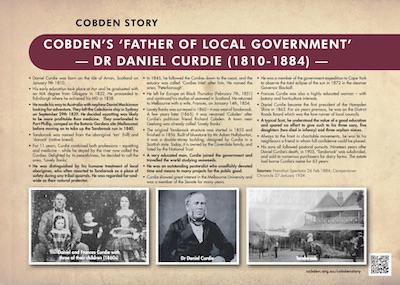Dr Daniel Curdie
COBDEN'S 'FATHER OF LOCAL GOVERNMENT' - DR DANIEL CURDIE (1810-1884) -

![]() This plaque is located on the Lake Cobden walking track, Shenfield St.
This plaque is located on the Lake Cobden walking track, Shenfield St.
- Daniel Curdie was born on the Isle of Arran, Scotland on January 9th 1810.
- His early education took place at Ayr and he graduated with an MA degree from Glasgow in 1832. He proceeded to Edinburgh where he achieved his MD in 1838.
- He made his way to Australia with nephew Daniel Mackinnon looking for adventure. They left the Caledonia ship in Sydney on September 29th 1839. He decided squatting was likely to be more profitable than medicine. They overlanded to Port Phillip, camped on the Botanic Gardens site (Melbourne) before moving on to take up the Tandarook run in 1840.
- Tandarook was named from the aboriginal ‘tan’ (hill) and ‘darook’ (native bread).
- For 11 years, Curdie combined both professions – squatting and medicine – while he stayed by the river now called the Curdies. Delighted by its peacefulness, he decided to call the area, ‘Lovely Banks’.
- He was distinguished by his humane treatment of local aborigines, who often resorted to Tandarook as a place of safety during any tribal quarrels. He was regarded far-and-wide as their natural protector.
- In 1845, he followed the Curdies down to the coast, and the estuary was called ‘Curdies Inlet’ after him. He named the area, ‘Peterborough’.
- He left for Europe on Black Thursday (February 7th, 1851) and continued his studies of seaweed in Scotland. He returned to Melbourne with a wife, Frances, on January 14th, 1854.
- Lovely Banks was surveyed in 1860 – it was west of Tandarook. A few years later (1865), it was renamed ‘Cobden’ after Curdie’s politician friend Richard Cobden. A town near Geelong was already called ‘Lovely Banks’.
- The original Tandarook structure was started in 1853 and finished in 1856. Built of bluestone by Mr Adam Hallyburton, it was a double-storey building, designed by Curdie in a Scottish style. Today, it is owned by the Coverdale family, and listed by the National Trust.
- A very educated man, Curdie joined the government and travelled the world studying seaweeds.
- He was an outstanding pastoralist who unselfishly devoted time and means to many projects for the public good.
- Curdie showed great interest in the Melbourne University and was a member of the Senate for many years.
- He was a member of the government expedition to Cape York to observe the total eclipse of the sun in 1872 in the steamer Governor Blackall.
- Frances Curdie was also a highly educated woman – with botany and horticulture interests.
- Daniel Curdie became the first president of the Hampden Shire in 1863. For six years previous, he was on the District Roads Board which was the fore-runner of local councils.
- A typical Scot, he understood the value of a good education and spared no effort to give such to his three sons, five daughters (two died in infancy) and three orphan nieces.
- Always to the front in charitable movements, he was to his neighbours a friend in whom full confidence could be placed.
- His sons all followed pastoral pursuits. Nineteen years after Daniel Curdie’s death, in 1903, ‘Tandarook’ was subdivided, and sold to numerous purchasers for dairy farms. The estate had borne Curdie’s name for 63 years.
- Sources: Hamilton Spectator 26 Feb 1884; Camperdown Chronicle 27 January 1934
